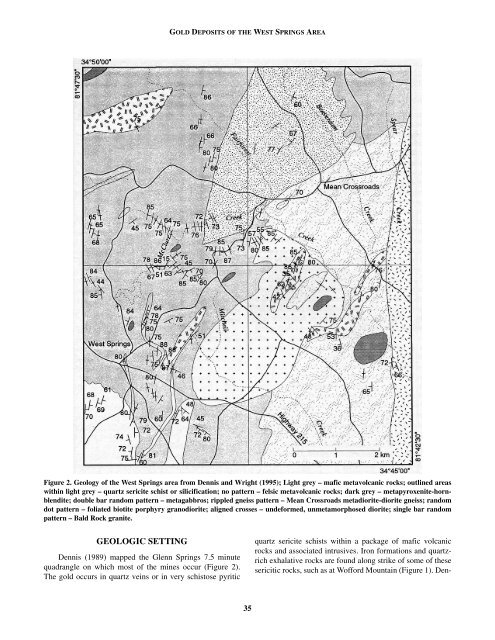Download Guidebook as .pdf (29.1 Mb) - Carolina Geological Society
Download Guidebook as .pdf (29.1 Mb) - Carolina Geological Society
Download Guidebook as .pdf (29.1 Mb) - Carolina Geological Society
Create successful ePaper yourself
Turn your PDF publications into a flip-book with our unique Google optimized e-Paper software.
GOLD DEPOSITS OF THE WEST SPRINGS AREA<br />
Figure 2. Geology of the West Springs area from Dennis and Wright (1995); Light grey – mafic metavolcanic rocks; outlined are<strong>as</strong><br />
within light grey – quartz sericite schist or silicification; no pattern – felsic metavolcanic rocks; dark grey – metapyroxenite-hornblendite;<br />
double bar random pattern – metagabbros; rippled gneiss pattern – Mean Crossroads metadiorite-diorite gneiss; random<br />
dot pattern – foliated biotite porphyry granodiorite; aligned crosses – undeformed, unmetamorphosed diorite; single bar random<br />
pattern – Bald Rock granite.<br />
GEOLOGIC SETTING<br />
Dennis (1989) mapped the Glenn Springs 7.5 minute<br />
quadrangle on which most of the mines occur (Figure 2).<br />
The gold occurs in quartz veins or in very schistose pyritic<br />
quartz sericite schists within a package of mafic volcanic<br />
rocks and <strong>as</strong>sociated intrusives. Iron formations and quartzrich<br />
exhalative rocks are found along strike of some of these<br />
sericitic rocks, such <strong>as</strong> at Wofford Mountain (Figure 1). Den-<br />
35













